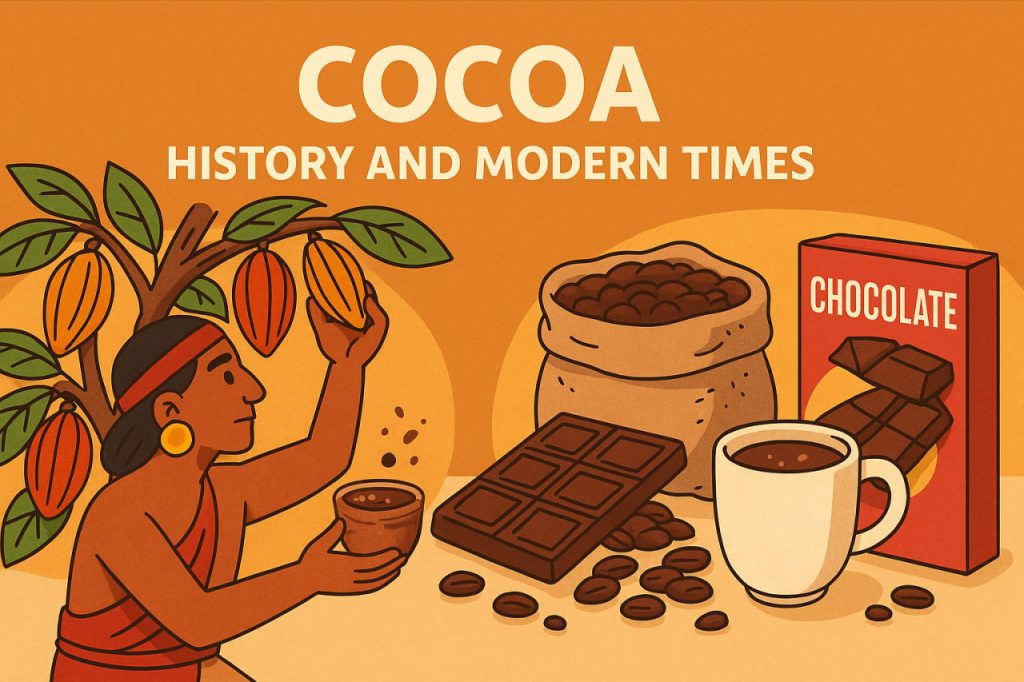Cocoa has a long and fascinating history that stretches back thousands of years. The earliest evidence of cocoa use comes from Central and South America, where the Maya and Aztec civilizations cultivated the cacao tree. They prepared a bitter drink made from ground cocoa beans mixed with water, spices, and sometimes chili. Cocoa was not only a food but also held cultural and religious significance. In Aztec society, cocoa beans were even used as currency, demonstrating their high value.
Cocoa in European History
Cocoa arrived in Europe in the 16th century after Spanish explorers brought it from the Americas. Initially, it was consumed as a bitter drink, but Europeans soon began sweetening it with sugar and cinnamon. This transformed cocoa into a popular luxury beverage among the aristocracy. By the 17th and 18th centuries, cocoa houses appeared in major European cities, much like coffee houses. Over time, technological innovations allowed cocoa to become more accessible to the general population.
The Birth of Chocolate
The 19th century marked a turning point when cocoa was processed into solid chocolate. New inventions such as the cocoa press made it possible to separate cocoa butter from cocoa powder, giving rise to new textures and flavors. Companies like Cadbury, Nestlé, and Lindt pioneered the production of chocolate bars, milk chocolate, and pralines. What began as a ceremonial drink in ancient civilizations became a global industry worth billions of dollars, transforming cocoa into one of the world’s most beloved products.
Cocoa in the Modern World
Today, cocoa is grown mainly in tropical regions such as West Africa, Latin America, and Southeast Asia. Countries like Côte d’Ivoire and Ghana supply more than half of the world’s cocoa. The industry supports millions of farmers, but it also faces challenges such as unstable prices, child labor, and environmental issues. Modern consumers demand not only high-quality chocolate but also ethically sourced and sustainably produced cocoa. Certification programs like Fairtrade aim to improve the lives of farmers and reduce exploitation.
Health Aspects of Cocoa
Cocoa is not just a treat but also has nutritional value. It contains flavonoids, natural compounds with antioxidant properties that support heart health and improve circulation. Dark chocolate with high cocoa content is often considered beneficial in moderation. However, many chocolate products are high in sugar and fat, reducing their health value. Scientists continue to study cocoa’s potential effects on mood, cognition, and overall well-being, highlighting its complex role in human diets.
The Future of Cocoa
The future of cocoa depends on balancing demand with sustainability. Climate change threatens cocoa-growing regions by altering rainfall and increasing temperatures. Innovations in agriculture, such as disease-resistant cacao trees and improved farming techniques, may help secure supply. At the same time, consumer awareness pushes the industry toward transparency and ethical sourcing. As technology and global trade evolve, cocoa will likely remain both a cultural symbol and a global commodity.
Conclusion
From ancient sacred drink to modern chocolate industry, cocoa has traveled a long journey through history. It shaped civilizations, influenced economies, and continues to delight people worldwide. Today, cocoa is both a pleasure and a challenge, as sustainability and ethics become central to its production. The story of cocoa reflects human creativity, cultural exchange, and the ongoing quest to balance enjoyment with responsibility.
Glossary
- Cocoa – processed product of cacao beans, used for drinks, chocolate, and other foods.
- Cacao tree – tropical tree that produces cocoa beans.
- Maya and Aztec – ancient civilizations that first cultivated and valued cocoa.
- Cocoa press – 19th-century invention that separated cocoa butter from cocoa solids.
- Fairtrade – certification ensuring fair wages and sustainable practices in farming.
- Flavonoids – natural plant compounds with antioxidant properties.


